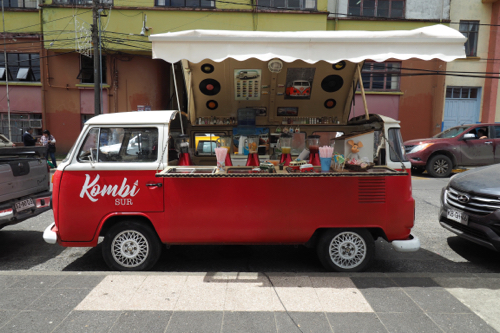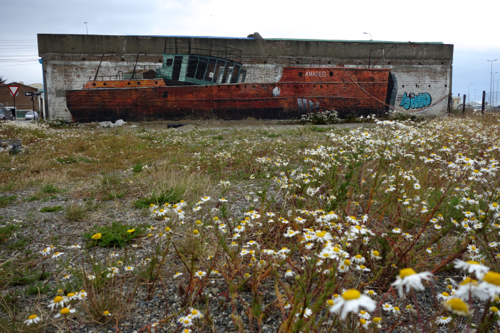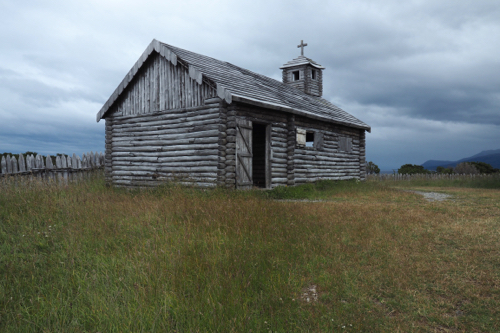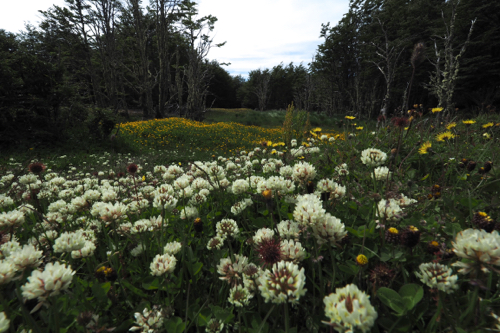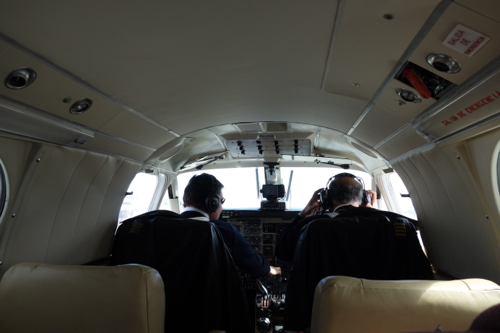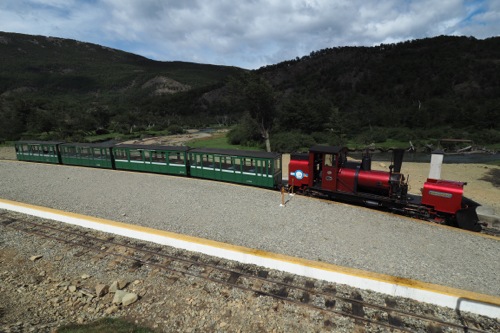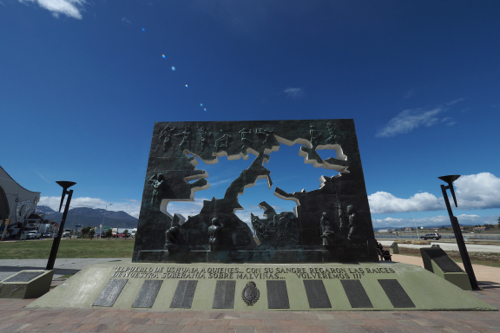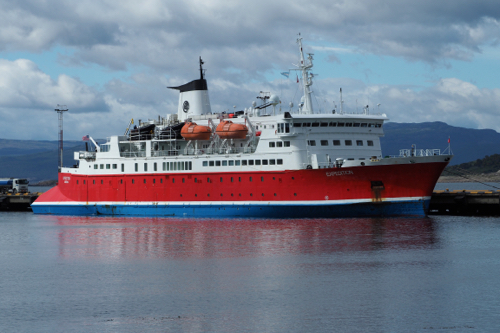January 21, 2018. Santiago to Puerto Montt, Chile.
The drive from the hotel in central Santiago to the airport was done at breakneck speed. Most of it is on freeways, which seemed to have no speed limit.
We covered the 19 kilometres, door-to-door, in 15 minutes.
The flight to Puerto Montt was a relatively easy 2:45 hours, as was picking up the Peugeot 301 from Avis at the airport.
Puerto Montt is in the Lake District of Chile and it seemed like a good opportunity to self drive for a few days.
We were now a lot further south, and the days were stretching out, so we had an afternoon drive to get a feel of the area. It also gave me an opportunity to get my ‘driving brain’ activated.
We drove about 20 kilometres east along the Pacific coast to Quillaipe.
In the evening we walked along the Puerto Montt waterfront and found the Club de Yates for dinner.
The food was good, the location excellent, but it was empty.
January 22, 2018. Puerto Montt, Chile.
Today was devoted to lakes and volcanos.
First we drove towards Lake Llanquihue, with the very imposing Osorno Volcano looming over the lake.
Lake Llanquihue is the second largest lake in Chile and covers an area of approximately 860 square kilometres. We drove around the edge of the lake and got some spectacular views of the volcano.
Osorno Volcano is described by some as the Mount Fuji of South America and you can see the similarities. It has a classical snow-capped peak standing 2,652 metres above sea level. It is also one of the most active volcanoes in the Southern Chilean Andes.
We drove to the foot of Osorno and took the chairlift to the top-most lookout. The views of both the volcano and the valley with lakes below were stunning. Apart from the Orsorno Volcano we could also see the Calbuco Volcano, which erupted as recently as 2015.
We continued our lake drive on to Lake Todos los Santos and the Petrohué River. Then it was back to Puerto Montt in the late afternoon.
Puerto Montt is an ugly town, but that is to be expected as it suffered a massive earthquake in 1960. The quake destroyed the port, train station and much of the civic and domestic buildings.
The resulting ‘modern’ architecture lacks the style and substance that you get from the colonial era.
The port rose to prominence during the 1990s and 2000s as Chile’s second largest salmon producer.
January 23, 2018. Puerto Montt, Chile.
More nature today as we headed off to the Island of Chiloé to see penguins and other bird life.
We crossed the Chacao Channel and then stopped at Ancud for a coffee.
Ancud sits on the banks of the Chacao Channel which has been dredged out by glaciation, separating Chiloé Island from the mainland and the Pacific Ocean.
The 30 minute boat excursion was a very slick affair.
No sooner had we paid our money, than we were fitted out with life jackets and sent off to board an inflatable boat. These were moored in the shallows and we were pushed out on specially designed wheeled platforms to reach them.
At Point Almenao we caught glimpses of penguins, various sea birds and South American Sea Lions, as we motored around the the Puñihuil Islands.
There were both Humboldt and Megellanic Penguins on the rocks but I couldn’t really tell the difference.
We drove 551 kilometres around Puerto Montt and each day was a totally different experience.
It was well worth the car hire.
January 24, 2018. Puerto Montt to Punta Arenas, Chile.
We awoke to find the window, in the hallway outside our room, hanging precariously from its hinges.
Who knows how it got like that.
Today’s flight, from Puerto Montt to Punta Arenas, would take us even further south, at 54° below the equator.
Our hotel in Punta Arenas, the Cabo de Hornes, was right on Plaza de Armas, the main square.
There were a lot more colonial buildings and had obviously not suffered from earthquakes like Puerto Montt.
The Cabo de Hornes was alive with expectant people, all waiting to board their ships to sail to the Antarctic. Punta Arenas was a major embarkation point to the frozen continent.
This gave us an insight into what we should expect when we reached Ushuaia in Argentina in a few days time.
Using what was remaining of the afternoon we wandered around the town and the waterfront.
Apart from the old colonial buildings the rest of the town was rather pedestrian, except for the graffiti.
Some of the waterfront buildings had spectacular murals painted on their facades.
January 25, 2018. Punta Arenas, Chile.
We had hired another car, this time a khaki coloured Renault Duster from Avis. It was a good colour for tanks, but not cars.
The day was spent at the Straits of Magellan Park, which is about 55 kilometres south of Punta Arenas.
Ferdinand Magellan (1480-1521) was a Portuguese explorer who, in 1520, was the first European to find a navigable sea route between Chile, in the north, and Tierra del Fuego, in the south. This allowed sailors to safely navigate from the Pacific to the Atlantic Oceans.
This was a very important part of the history and development of the New World, especially southern South America. It allowed for sailors to circle the globe, without having to venture into Antarctica and the dangerous waters of the Drake Passage.
Fuerte Bulnes is situated on the Straits of Magellan and is 65 kilometres south of Punta Arenas.
The fort, built in 1843, was designed to help Chile ward off attempts by other nations to claim the straits for themselves.
In 1848, after the founding of Punta Arenas, and due to the remoteness and harsh conditions of the settlement, the fort was abandoned and the buildings destroyed. Between 1941 and 1943 the government ordered a reconstruction be built of the historic site.
Today the replicas include the church, chaplain’s quarter, jail, gun powder room, post office and stables.
January 26, 2018. Punta Arenas, Chile.
This was our second day of nature.
About 8 kilometres out of town was the Magellan National Park. Yes more things named Magellan.
Created in 1932 this national reserve of 13,500 hectares is on the coast and offers great views of the surrounding area.
We walked about 8 kilometres through forests, bush-lands and windswept pathways. The wind was gusting to about 80 kph and a couple of times we nearly lost our footing, especially when we climbed to the Mirador Zapador Austral.
Our hats did find themselves in the bushes on a few occasions.
January 27, 2018. Punta Arenas, Chile to Ushuaia, Argentina.
Our international flight from Punta Arenas, in Chile, to Ushuaia, in Argentina, was in a Beechcraft King Air 100.
It was an adventurous flight with a lot of turbulence on take off and landing.
The in-flight briefing consisted of the pilot turning around from the cockpit and explaining all the procedures.
It’s strange how even a one hour flight, in a light aircraft, can still take an entire day.
Even though the six of us on the Beechcraft had our own immigration officer in Punta Arenas and Ushuaia, it still took time.
We even had our own baggage claim on arrival in Ushuaia.
The Beechcraft King Air 100 did look rather small on the tarmac at Ushuaia Airport. Especially in comparison to the nearby jets.
After settling into our hotel we went out into the main shopping street of Ushuaia. We needed a few things for our Antarctic trip, so a visit to the local outdoor stores was needed.
January 28, 2018. Ushuaia, Argentina.
El Tren del Fin del Mundo (The Train of the End of the World)
It operated between 1910 and 1947 and was primarily used to transport freight, especially timber, to the prison in Ushuaia and is now a tourist railway.
We travelled 7km, of the original 14km, that was once the originally track.
At the end of the hour’s journey from Ushuaia we walked from the station down to Ensenada Zaratiegui Bay, which is on the Beagle Channel. From there we did a short walk along the coastal path in the Tierra del Fuego National Park.
It was then the long haul, back up the hill to the station, and the return train trip to Ushuaia.
This only took 40 minutes as there were no stops.
There are a number of ‘ests’ in Ushuaia.
It is the most southern city in the world, as is the international airport and golf course. The railway is the world’s most southern functioning line.
Ushuaia was founded in 1884 by Augusto Lasserre, an Argentinian naval officer, and is on the shores of the Beagle Channel.
Today Ushuaia is a key access point for tourists and scientific expeditions to the Southern Ocean and Antarctica.
As an interesting aside, in 2014 the cast and crew of Top Gear, who were filming in Ushuaia were chased out of the city. Apparently reference to the Falklands War was encoded in the registration of Jeremy Clarkson’s vehicle.
January 29, 2018. Ushuaia, Argentina.
“Don’t cry for me Argentina.”
Just next to our hotel there was a monument to Eva Peron (1919-1952). Eva was born into poverty and rose to become the First Lady of Argentina in 1946 until her death. She was immortalised in the Andrew Lloyd Webber musical Evita and is a loved figure in Argentina, even today.
There are Eva Peron monuments everywhere.
Other than a brief walk around our hotel, it was a quiet day.
Over the next 48 hours the Antarctica tour group would start to arrive, so we decided it was time for a day of organising.
Backing up computers and sorting out paperwork was boring, but it had to be done.
January 30, 2018. Ushuaia, Argentina.
This was the last full day of being on our own (freedom) before joining the Antarctic cruise.
The others, who arrived the previous day, were off doing the ‘El Tren del Fin del Mundo’.
We spent some time on last minute shopping for the cruise and a bit of sightseeing around Ushuaia.
On the edge of the town is a memorial to the Falklands War.
As mentioned previously, this is a very touchy subject in Argentina.
The only people to call it the Falklands War are the Brits. The Argentinians refer to it as Malvinas War, in reference to their name for the Falkland Islands, or Guerra del Atlántoco Sur, meaning South Atlantic War.
Just off the coastline is the wreck of the Saint Christopher. Originally built in the US in 1943, as a rescue tug, she was transferred to the Royal Navy and was renamed HMS Justice (W140). She returned to the US at the end of WWII and then sold for commercial service in Argentina and re named the Saint Christopher.
After suffering engine trouble and rudder damage, she was laid up and eventually beached in Ushuaia in 1957.
January 31, 2018. Ushuaia, Argentina, then sailing towards Antartica.
After breakfast we packed and left our bags in reception. The next time we would see them would be on the ship.
Even at ‘The End of the Earth’ you can get good coffee. On our first day in Ushuaia we discovered Dali Café, it was just around the corner from our hotel.
We made one last visit – who knows what the coffee would be like on the ship.
We then had one more sight seeing excursion.
The End of the World Prison in Ushuaia holds four museums and an art gallery. The Prison Museum, Maritime Museum and Antarctic Museum.
The ticket gave us 48 hours to visit and you would certainly need all that time if you wanted to read all the notations.
Every cell in the prison was an exhibit.
They covered everything from the prison itself to prisons of the world and a raft of other topics.
There was an entire cell dedicated to Australian prisons. Even Pentridge in Melbourne was featured.
Antartica, explorers, aviation, natural history, oil exploration the armed forces and police, all had exhibits.
It was a big prison.
Then there was the Historic Pavilion, which had left the cells in their original, cold, condition.
Even the gallery and gift shop utilised the cells to exhibit art and souvenirs.
The building was an amazing complex with five radiating arms of cells, each with two levels. At the centre was a large enclosed hall which was used to muster the prisoners.
After the cultural experience of the prison/museum we returned to the hotel and joined the group.
Next was boarding and the start of our Antarctic adventure.


